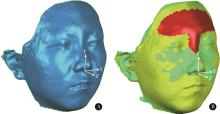Journal of Peking University (Health Sciences) ›› 2024, Vol. 56 ›› Issue (1): 111-119. doi: 10.19723/j.issn.1671-167X.2024.01.018
Previous Articles Next Articles
Soft and hard tissue changes of hyperdivergent class Ⅱ patients before and after orthodontic extraction treatment
Bochun MAO,Yajing TIAN,Xuedong WANG*( ),Jing LI*(
),Jing LI*( ),Yanheng ZHOU
),Yanheng ZHOU
- Department of Orthodontics, Peking University School and Hospital of Stomatology & National Center for Stomatology & National Clinical Research Center for Oral Diseases & National Engineering Research Center of Oral Biomaterials and Digi-tal Medical Devices, Beijing 100081, China
CLC Number:
- R783.5
| 1 |
Reis PMP , Lima P , Garcia FCP , et al. Effect of maxillary median diastema on the esthetics of a smile[J]. Am J Orthod Dentofacial Orthop, 2020, 158 (4): E37- E42.
doi: 10.1016/j.ajodo.2020.07.028 |
| 2 | 施丹妮, 杨鑫, 吴建勇. 锥形束CT三维头影测量参考坐标系的研究进展[J]. 国际口腔医学杂志, 2021, 48 (4): 398- 404. |
| 3 |
Ferrario VF , Sforza C , Schmitz JH , et al. A three-dimensional computerized mesh diagram analysis and its application in soft tissue facial morphometry[J]. Am J Orthod Dentofacial Orthop, 1998, 114 (4): 404- 413.
doi: 10.1016/S0889-5406(98)70185-4 |
| 4 |
Xiao Z , Liu Z , Gu Y . Integration of digital maxillary dental casts with 3D facial images in orthodontic patients: A three-dimensional validation study[J]. Angle Orthod, 2020, 90 (3): 397- 404.
doi: 10.2319/071619-473.1 |
| 5 |
Janson G , Mendes LM , Junqueira CHZ , et al. Soft-tissue changes in class Ⅱ malocclusion patients treated with extractions: A systematic review[J]. Eur J Orthod, 2016, 38 (6): 631- 637.
doi: 10.1093/ejo/cjv083 |
| 6 |
Konstantonis D , Vasileiou D , Papageorgiou SN , et al. Soft tissue changes following extraction vs. nonextraction orthodontic fixed appliance treatment: A systematic review and meta-analysis[J]. Eur J Oral Sci, 2018, 126 (3): 167- 179.
doi: 10.1111/eos.12409 |
| 7 | 谢天伊, 贾绮林. 成年女性正畸患者颊颞部软组织变化的三维测量研究[J]. 中华口腔正畸学杂志, 2020, 27 (4): 181- 186. |
| 8 |
Lu WX , Zhang X , Mei L , et al. Orthodontic incisor retraction caused changes in the soft tissue chin area: A retrospective study[J]. BMC Oral Health, 2020, 20 (1): 108.
doi: 10.1186/s12903-020-01099-2 |
| 9 |
Tadic N , Woods MG . Incisal and soft tissue effects of maxillary premolar extraction in class Ⅱ treatment[J]. Angle Orthod, 2007, 77 (5): 808- 816.
doi: 10.2319/081706-336 |
| 10 |
Veltkamp T , Buschang PH , English JD , et al. Predicting lower lip and chin response to mandibular advancement and genioplasty[J]. Am J Orthod Dentofacial Orthop, 2002, 122 (6): 627- 634.
doi: 10.1067/mod.2002.128864 |
| 11 |
Choi SH , Lee H , Hwang JJ , et al. Differences in soft-tissue thickness changes after bimaxillary surgery between patients with vertically high angle and normal angle[J]. Am J Orthod Dentofacial Orthop, 2021, 159 (1): 30- 40.
doi: 10.1016/j.ajodo.2019.10.028 |
| 12 |
Holdaway RA . A soft-tissue cephalometric analysis and its use in orthodontic treatment planning. Part Ⅰ[J]. Am J Orthod, 1983, 84 (1): 1- 28.
doi: 10.1016/0002-9416(83)90144-6 |
| 13 |
Hodges A , Rossouw PE , Campbell PM , et al. Prediction of lip response to four first premolar extractions in white female adolescents and adults[J]. Angle Orthod, 2009, 79 (3): 413- 421.
doi: 10.2319/050208-247.1 |
| 14 |
Upadhyay M , Yadav S , Nagaraj K , et al. Treatment effects of mini-implants for en-mass eretraction of anterior teeth in bialveolar dental protrusion patients: A randomized controlled trial[J]. Am J Orthod Dentofacial Orthop, 2008, 134 (1): 18- 29.
doi: 10.1016/j.ajodo.2007.03.025 |
| 15 |
Sivakumar A , Valiathan A . Cephalometric assessment of dentofacial vertical changes in class Ⅰ subjects treated with and without extraction[J]. Am J Orthod Dentofacial Orthop, 2008, 133 (6): 869- 875.
doi: 10.1016/j.ajodo.2006.05.041 |
| [1] | Yu FU,Xin-nong HU,Sheng-jie CUI,Jie SHI. Decompensation effectiveness and alveolar bone remodeling analysis of mandibular anterior teeth after preoperative orthodontic treatment in high-angle patients with skeletal class Ⅱ malocclusion [J]. Journal of Peking University (Health Sciences), 2023, 55(1): 62-69. |
| [2] | ZHOU Jing,LIU Yi. Cone-beam CT evaluation of temporomandibular joint in skeletal class Ⅱ female adolescents with different vertical patterns [J]. Journal of Peking University (Health Sciences), 2021, 53(1): 109-119. |
|
||

